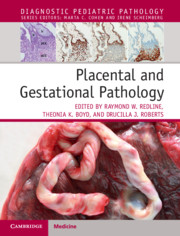Book contents
- Placental and Gestational Pathology
- Diagnostic Pediatric Pathology
- Placental and Gestational Pathology
- Copyright page
- Contents
- Contributors
- Preface
- Section 1 Introduction
- Section 2 Early Pregnancy Pathology
- Section 3 Maternal Uteroplacental-Vascular Pathology
- Section 4 Fetal Stromal-Vascular Pathology
- Section 5 Inflammatory Processes
- Section 6 Other Pathologic Processes
- Chapter 16 Placental Size, Shape, and Umbilical Cord Abnormalities
- Chapter 17 Perivillous Fibrin Deposition
- Chapter 18 Atypical Intraplacental Hemorrhages / Thrombi
- Chapter 19 Meconium Effects
- Chapter 20 Increased Circulating Fetal Nucleated Red Blood Cells
- Chapter 21 Early and Late Membrane / Amnion Rupture and Amnion Nodosum
- Chapter 22 Metastatic Tumors
- Chapter 23 Heterotopias and Germ Cell Tumors
- Chapter 24 Lysosomal Storage Disease, Bartter Syndrome, and Mimics
- Section 7 Pathology of Multiple Gestations
- Section 8 Uteroplacental Pathology
- Section 9 Clinicopathologic Correlations: Placental Pathology and Adverse Pregnancy Outcomes
- Book part
- Index
- References
Chapter 17 - Perivillous Fibrin Deposition
from Section 6 - Other Pathologic Processes
Published online by Cambridge University Press: 03 September 2018
- Placental and Gestational Pathology
- Diagnostic Pediatric Pathology
- Placental and Gestational Pathology
- Copyright page
- Contents
- Contributors
- Preface
- Section 1 Introduction
- Section 2 Early Pregnancy Pathology
- Section 3 Maternal Uteroplacental-Vascular Pathology
- Section 4 Fetal Stromal-Vascular Pathology
- Section 5 Inflammatory Processes
- Section 6 Other Pathologic Processes
- Chapter 16 Placental Size, Shape, and Umbilical Cord Abnormalities
- Chapter 17 Perivillous Fibrin Deposition
- Chapter 18 Atypical Intraplacental Hemorrhages / Thrombi
- Chapter 19 Meconium Effects
- Chapter 20 Increased Circulating Fetal Nucleated Red Blood Cells
- Chapter 21 Early and Late Membrane / Amnion Rupture and Amnion Nodosum
- Chapter 22 Metastatic Tumors
- Chapter 23 Heterotopias and Germ Cell Tumors
- Chapter 24 Lysosomal Storage Disease, Bartter Syndrome, and Mimics
- Section 7 Pathology of Multiple Gestations
- Section 8 Uteroplacental Pathology
- Section 9 Clinicopathologic Correlations: Placental Pathology and Adverse Pregnancy Outcomes
- Book part
- Index
- References
- Type
- Chapter
- Information
- Placental and Gestational Pathology , pp. 181 - 187Publisher: Cambridge University PressPrint publication year: 2017



